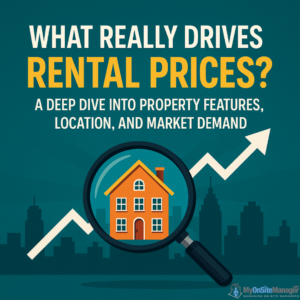Setting the right rental price isn’t guesswork—it’s a calculated decision based on three major elements: the property’s features, its location, and the current market demand. Whether you’re managing a single-family home, multifamily units, or apartment complexes, knowing how these factors interact can mean the difference between a vacant property and a profitable one.
In this post, we break down each of these factors to help you determine how much your rental is really worth—and how to maximize its value.
1.Property Features: The Foundation of Rent Value
The tangible elements of your rental—its structure, amenities, and upgrades—are often the first thing potential tenants notice. Here’s how specific features impact rent:
Size & Layout
-
More Bedrooms = More Rent: Properties with additional bedrooms or bathrooms naturally attract larger households and command higher rates.
-
Functional Layouts Matter: An awkward floor plan, even in a large space, can limit your rental potential. Open-concept living areas, natural light, and privacy between rooms are highly desirable.
Example: A 2-bedroom, 1-bath home with an open kitchen may rent for more than a 3-bedroom unit with outdated layout and finishes.
Quality of Finishes & Appliances
-
Stainless steel appliances, granite countertops, and hardwood floors boost appeal.
-
Energy-efficient systems (HVAC, LED lighting, smart thermostats) not only attract environmentally conscious renters but can also justify higher rent due to utility savings.
In-Demand Amenities
-
In-unit washer/dryer, private parking, fenced yards, high-speed internet readiness, and pet-friendliness are among the top amenities renters are willing to pay more for.
-
Properties with outdoor spaces—like patios, balconies, or gardens—also fetch a premium, especially post-pandemic.
Pro Tip: Consider modest upgrades to outdated units. Even simple changes like repainting, new lighting, or replacing cabinet hardware can boost rental value with minimal investment.
2.Location: The Multiplier Effect on Rent
“Location, location, location” isn’t just a cliché—it’s one of the most powerful predictors of rental price.
Proximity to Key Services
-
Properties near public transit, freeways, job centers, universities, hospitals, and shopping districts consistently rent for more.
-
Walkability and bike-friendliness are major pluses in urban environments.
Example: A one-bedroom apartment in a central downtown area may rent for 2x the price of a similar unit 10 miles away in a less connected suburb.
Neighborhood Safety & Reputation
-
Low crime rates and family-friendly environments are crucial for long-term rentals. People are willing to stretch their budgets for peace of mind.
-
Communities with active HOAs, regular maintenance, and organized local events tend to attract more responsible tenants.
School Districts
-
Even tenants without children consider school ratings because strong districts preserve property value and signal neighborhood quality.
-
Homes zoned to highly rated schools often see a 10–20% rent premium.
Local Economic Trends
-
Are new businesses opening nearby? Is the population growing? Is there a university, military base, or new tech park? These can create upward rental pressure.
-
Gentrification, rezoning, or infrastructure projects can push rents higher in previously undervalued areas.
3.Market Demand: Timing Is Everything
Even the best property in the best location won’t rent well if market conditions are soft. Understanding supply and demand in your local rental market is essential.
Supply vs. Demand
-
If your area is flooded with rental listings, you may need to offer competitive pricing or flexible lease terms.
-
In hot markets with limited vacancies, landlords have the upper hand and can charge top dollar.
Seasonality
-
Spring and summer are prime leasing seasons when families move before the new school year and college students relocate.
-
Listing in off-peak months like November or December may require rent concessions or added perks (e.g., free month, utilities included).
Tenant Demographics & Preferences
-
Millennials prioritize digital connectivity, pet-friendliness, and flexible spaces for remote work.
-
Gen Z is increasingly looking for green features and community engagement.
-
Baby boomers downsizing from homes want convenience, accessibility, and low maintenance.
Economic Climate
-
Rising interest rates may push more would-be buyers into renting, increasing demand.
-
However, inflation can also reduce what tenants are willing (or able) to pay.
Tip: Always research market comparables (“comps”) before listing. Use platforms like Zillow, Rentometer, Zumper, and local MLS data.
How to Optimize Your Rental Pricing Strategy
| Tactic | Description |
|---|---|
| Benchmark Competitors | Compare your unit to similar properties in your area. Stay within $50–$150 range of comps unless you offer significant upgrades. |
| Enhance Your Listing | Use professional photos, highlight amenities, and include keywords that attract search traffic. |
| Offer Value-Adds | Consider bundling in services like internet, landscaping, or trash removal for a modest rent increase. |
| Adjust Quickly | If your unit doesn’t rent in 2–3 weeks, reevaluate pricing or listing presentation. |
| Know When to Increase Rent | Use lease renewals as an opportunity to raise rent—but do it within legal limits and communicate clearly to avoid turnover. |
Final Thoughts: Balancing Profitability With Market Realities
There’s no one-size-fits-all answer when it comes to rental pricing. Your goal should be to align the property’s strengths with tenant desires and local demand. By focusing on what renters truly value—comfort, convenience, community—you’ll not only price smarter but also reduce vacancies, attract better tenants, and improve long-term returns.
For landlords, property managers, and investors, staying informed and responsive to these three critical factors—property features, location, and market demand—can set your rental strategy apart in a competitive market.
Source: Key Factors Affecting Rental Prices: Property Features, Location, and Market Demand

